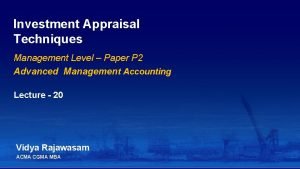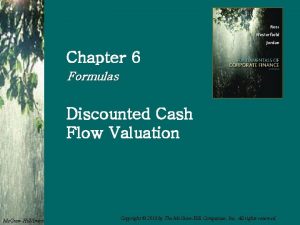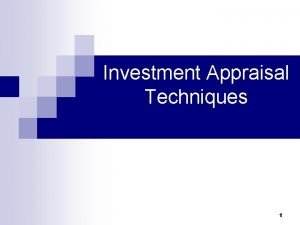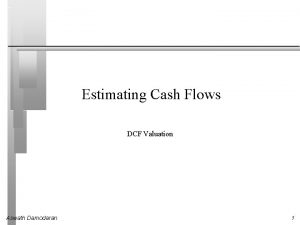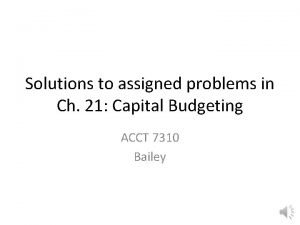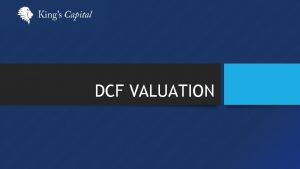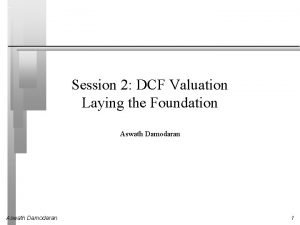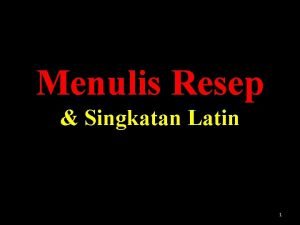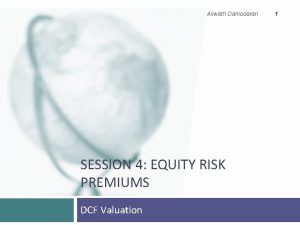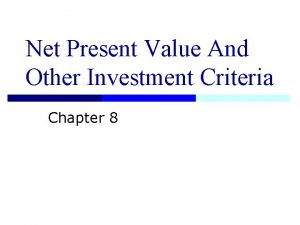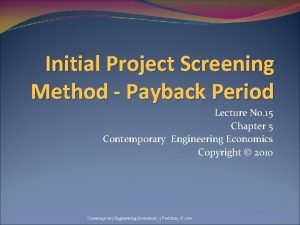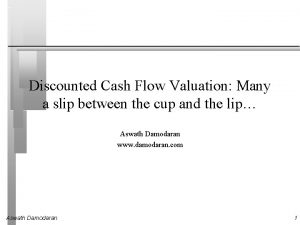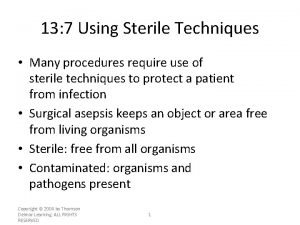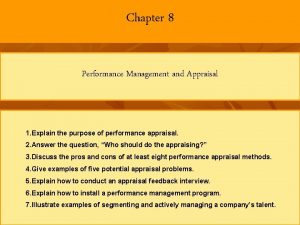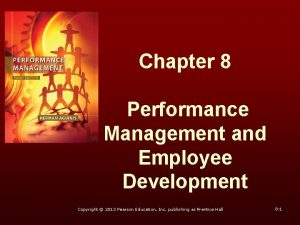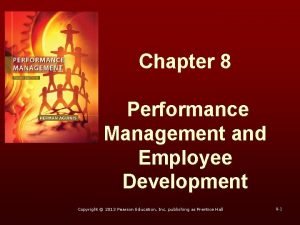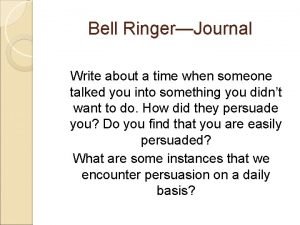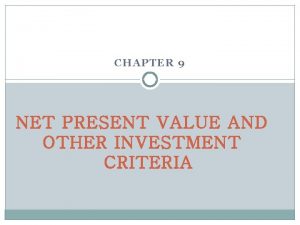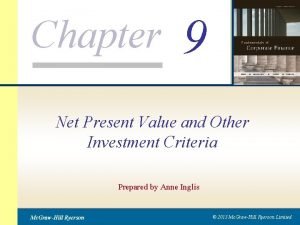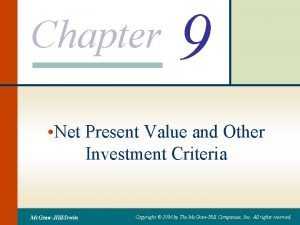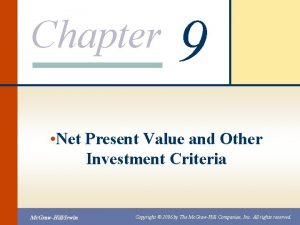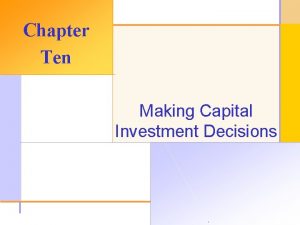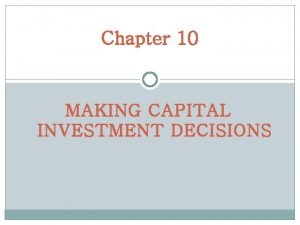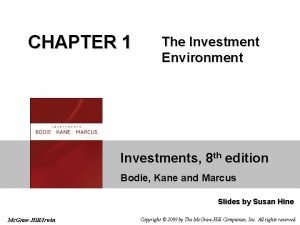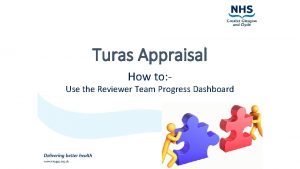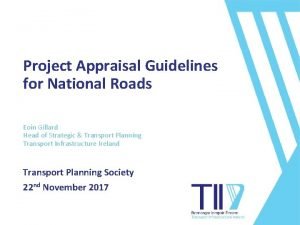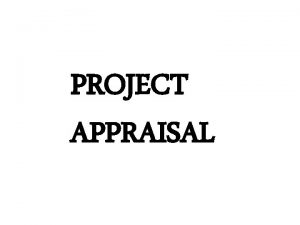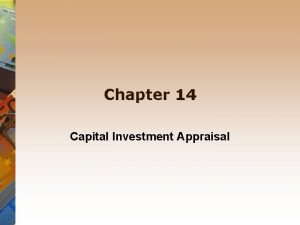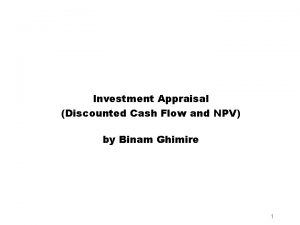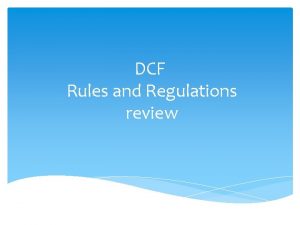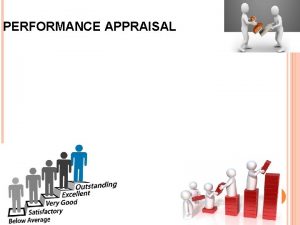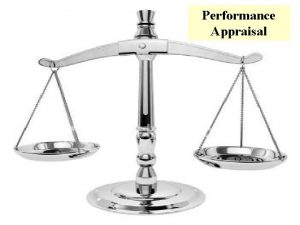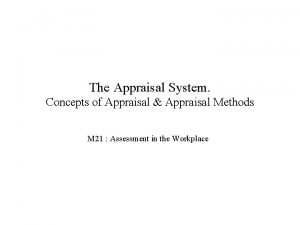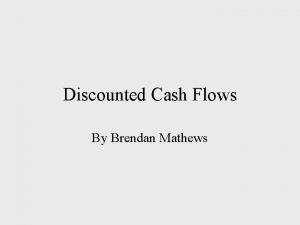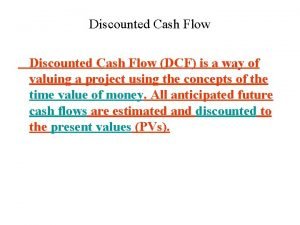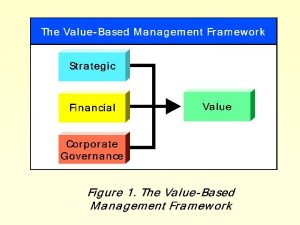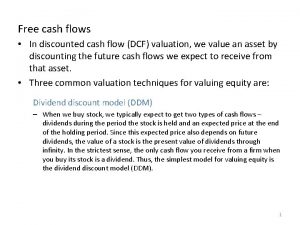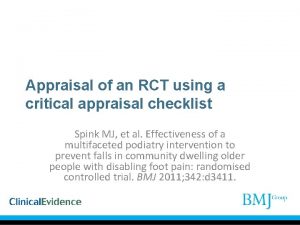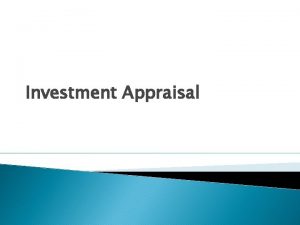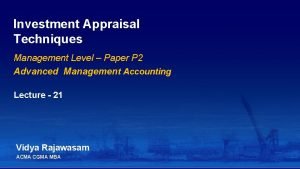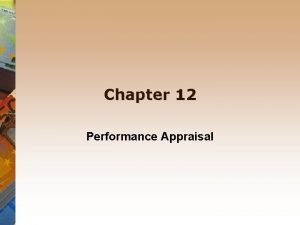Chapter 8 Investment appraisal using DCF techniques Discounted



























































- Slides: 59

Chapter 8 Investment appraisal using DCF techniques • Discounted cash flow • The net present value method • The internal rate of return method • NPV and IRR compared • Assessment of DCF methods of project appraisal 00 MON TH 0000

Overview Maximisation of shareholder wealth Investment decision Financing decision Dividend decision Investment appraisal using DCF methods Positive net present value investments create wealth for shareholders and should drive up the share price, as long as they can be financed. Internal rate of return shows the % return given by a project. If this return is higher than the cost of capital then the project should create wealth for shareholders and drive up the share price.

Syllabus learning outcomes • • Calculate net present value and discuss its usefulness as an investment appraisal method. Calculate internal rate of return and discuss its usefulness as an investment appraisal method. Discuss the superiority of DCF methods over non-DCF methods. Discuss the relative merits of NPV and IRR.

Key models and theories Discounted cash flow is an absolutely essential skill for paper F 9. Key techniques are: • • Net present value Internal rate of return Most exam questions bring in complications, such as inflation, which will be introduced in the next chapter.

Investment decisions using DCF techniques • • This chapter will look at investment decisions using discounted cash flow (DCF) techniques. DCF uses discounting to take into account changes in the value of money over time. There are two DCF methods: Net Present Value (NPV) and Internal Rate of Return (IRR). DCF is generally considered to be the most theoretically sound technique for investment appraisal.

Introduction to discounting (1) • Would you rather have $1, 000 now or $1, 000 in one year's time? • Most people prefer $1, 000 now because: – It can be spent and enjoyed now. – There is less risk. – It can be invested now and will be worth more after a year. • The last advantage can be quantified.

Introduction to discounting (2) • Interest rate = 10% Event Value after 1 year Receive $1, 000 now, invest $1, 000 × 1. 1 = $1, 100 for a year @10% Receive $1, 000 in one year • $1, 000 So the true values when compared at the same point in time are $1, 100 and $1, 000. These are the terminal values – what you would end up with.

Introduction to discounting (3) • Instead of projecting flows into the future, discounting asks 'What must you receive now to be equivalent to that future amount? ' • How much would you need to receive now (P, the present value) to be equivalent to receiving $1, 000 in one year if interest rates are 10%? $P × (1 + 10%) = $1, 000 $P = $1, 000/(1 + 10%) = 909. 09 • Note If $909. 09 is received now and invested at 10% it will become $1, 000 in one year. • $909. 09 is the present value of $1, 000 in one year.

Question to consider What is the present value of the following cash flows: (a) $10, 000 received in three years if interest rates are 4% (b) $10, 000 received in ten years if interest rates are 4% (c) $10, 000 received in three years if interest rate are 10% Remember, work out how much you would need to receive now (the present value) to grow to the amount received: P (1 + r)n = Amount received; r = rate as a decimal and n = number of years P = Amount received ×

Answer (a) $10, 000 received in three years if interest rates are 4% P = $10, 000 × 1/(1 + 0. 04)3 = $8, 890 (b) $10, 000 received in ten years if interest rates are 4% P = $10, 000 × 1/(1 + 0. 04)10 = $6, 756 (c) $10, 000 received in three years if interest rate are 10% P = $10, 000 × 1/(1 + 0. 10)3 = $7, 513 Note how the present value gets smaller as: • • Interest rates rise (compare (a) and (c)) The period gets longer (compare (a) and (b))

Question to consider Which of the following offers is better? (a) $4, 000 received in three years if interest rates are 5% (b) $6, 000 received in seven years if interest rates are 6% Remember, work out how much you would need to receive now (the present value) to grow to the amount received. P (1 + r)n = Amount received; r = rate as a decimal and n = number of years P = Amount received ×

Answer (a) $4, 000 received in three years if interest rates are 5% P = $4, 000/(1 + 0. 05)3 = $3, 455 (b) $6, 000 received in seven years if interest rates are 6% P = $6, 000/(1 + 0. 06)7 = $3, 990 Offer (b) is preferable as it has the higher present value.

Discount tables • The previous examples worked out present values from first principles ie to convert an amount received at time 3 when interest rates are 10%, multiply by the discount factor of 1/(1 + 0. 1)3, or 0. 751. • To make the calculations Present value of 1 ie (1 + r) easier, discount factor Where r = discount rate n = number of periods until payment tables are provided in Discount rate (r) the exam. You should use Periods the tables whenever you (n) 1% 2%. . 9% 10% can – then 1 0. 990 0. 980 0. 917 0. 909 0. 842 0. 826 your answers will be rounded 2 0. 980 0. 961 3 0. 971 0. 942 0. 772 0. 751 in the same way as the examiner’s. -n 4 0. 961 0. 924 0. 708 0. 683

Annuities (1) • Annuities are constant annual amounts. • They are common in DCF questions, for example, constant rent, constant sales prices and volumes. • Annuity tables provide a short-cut for working out the required discount factors. • It is important to use annuity tables whenever possible as they greatly speed up your calculations (which is very important in the exam).

Annuities (2) $2, 000 per year will be received for years 1– 3. What is the present value of the receipts if the discount rate is 8%? Long way Short way Time Flow 8% factor DCF 1 2, 000 0. 926 1, 852 2 2, 000 0. 857 1, 714 3 2, 000 0. 794 Totals 2. 577 Time Flow 8% factor 1– 3 2, 000 2. 577 The 8%, 3 year factor from the annuity tables DCF

Annuity tables Note: • These give the sum of the individual discount factors from time onwards. • Annuity factors are sometimes referred to as 'cumulative discount factors'. • If the cash flows are not a perfect annuity. . .

Question to consider: annuity tables Using annuity tables, calculate the present value of the following cash flows: (a) $2, 000 received for ten years, with the first flow occurring at time 2. Discount rate = 10% (b) $3, 000 received for six years with the first flow occurring at time 4. Discount rate = 6% (c) $4, 000 received for six years: times 1 – 3 then times 6 – 8. Discount rate = 12%

Answer: annuity tables (1) (a) $2, 000 received for 10 years, with the first flow occurring at time 2. Discount rate = 10% A 'normal' ten year annuity is received in years 1 – 10. This one is received in years 2 – 11, which is like 1 – 11, but omitting year 1. Flow timings Discount factor Times 1 – 11 6. 495 Less: Time 1 ( ) Times 2 – 11 The present value of the flows is therefore: 5. 586 × $2, 000 = $11, 172.

Answer: annuity tables (2) (b) $3, 000 received for six years with the first flow occurring at time 4. Discount rate = 6% A 'normal' six year annuity is received in years 1 – 6. This one is received in years 4 – 9, which is like 1 – 9, but omitting years 1 – 3. Flow timings Times 1 – 9 Less: Times 1 – 3 Discount factor 6. 802 ( ) Times 4 – 9 The present value of the flows is therefore: 4. 129 × $3, 000 = $12, 387.

Answer: annuity tables (3) (c) $4, 000 received for six years: times 1 – 3 then times 6 – 8. Discount rate = 12% These payments are received in years 1 – 3 then 6 – 8, which is like 1 – 8, but omitting years 4 and 5. Flow timings Discount factor Times 1 – 8 4. 968 Less: Time 4 (0. 636) Less: Time 5 ( ) Times 1 – 3 & 6 – 8 The present value of the flows is therefore: 3. 765 × $4, 000 = $15, 060.

Annuity factors that are not on the tables Very occasionally, you might have to deal with a discount rate that is not on the discount tables, eg 10. 5%, or for periods of over 15 years. There is a formula at the top of the Annuity Tables: Present value of an annuity of 1 = Or sometimes written as:

Question to consider: annuity factors A company will receive $10, 000 for 25 years. Discount rate = 15. 5%. What is the present value of the cash flows? Present value of an annuity of 1 = Or: A B C D $157 $62, 760 $205, 953 $250, 000

Answer: annuity factors A company will receive $10, 000 for 25 years. Discount rate = 15. 5%. What is the present value of the cash flows? Present value of an annuity of Or: Answer B PV = 62, 760

Perpetuities A perpetuity is a constant annual amount received forever. Some cash flows approximate to perpetuities eg a lease of 99 years. Present value of an annuity of In the formula above, as n gets very large, the (1 + r)-n becomes very small and the formula becomes Discount factor for a perpetuity =

Question to consider: perpetuities A company will pay rent of $25, 000 for 99 years. The rent will begin at time 3. Using a discount rate of 9% and assuming the rental period can be approximated to a perpetuity, what is the present value of the rent payments? Cumulative discount factor for a perpetuity = 1/r [Take care! As with annuities, normal perpetuities start at Time = 1] A $170, 525 B $214, 500 C $233, 800 D $277, 775

Answer: perpetuities A company will pay rent of $25, 000 for 99 years. The rent will begin at time 3. Discount rate = 9% Answer C A 'normal' perpetuity is For years 1 – ∞. This one is received in years 3 – ∞ so years 1 and 2 have to be omitted. Flow timings Discount factor 1–∞ Less 1 and 2 3 –∞ PV of the rental payments = 9. 352 × 25, 000 = $233, 800 1/0. 09 = 11. 111

Net present value (or NPV) of a project is the value obtained by discounting all cash outflows and inflows by a chosen target rate of return or cost of capital and adding them. • • • Discounting cash flows to their present values means that flows occurring at different times can be validly compared. If the net of the inflows and outflows is positive (a positive NPV), the project is worthwhile as the investor will be richer. If the NPV is negative then the project is not worthwhile and should be rejected.

Simplifying assumptions in NPV • A cash flow incurred at the beginning of a project ('now') occurs in year 0. The present value of $1 now, in year 0, is $1 regardless of the value of r. • A cash flow occurring during a time period is assumed to occur at the end of the time period. Eg, a receipt of $100 during year 1 is taken to occur at the end of year 1. • A cash flow at the beginning of a period is assumed to occur at the end of the previous year. Eg, a cash outlay of $5, 000 at the beginning of year 2 is taken to occur at the end of year 1.

Question to consider: NPV A new machine will cost $50, 000 and will produce net cash inflows of: Year 1 $20, 000 Year 2 $40, 000 Year 3 $25, 000 The machine can be sold for $10, 000 at the end of the project. Using the NPV method and a discount rate of 10%, is the project worthwhile?

Answer: NPV The cash flows and NPV calculation can be set out as: Time Description Flow Discount factor Discounted cash flow 0 Cost (50, 000) 1 1 Income 20, 000 0. 909 18, 180 2 Income 40, 000 0. 826 33, 040 3 Income 25, 000 0. 751 18, 775 3 Scrap sale 10, 000 0. 751 7, 510 NPV 27, 505 (50, 000) Because the NPV is positive the project is worthwhile and should be accepted. It should increase shareholder wealth.

DCF – relevant costs and income The criterion for identifying costs or income that are relevant to investment appraisal using DCF is the same as explained in the previous chapter. Simply ask: What cash flows are changed by the decision? So, amounts are relevant only if they are: • • • Future Incremental Cash flows

Examples of non-relevant costs for DCF • • • What cash flows are changed by the decision? Exclude: Sunk or past costs: this money is already spent and not changed by the decision Book values: the residue of past expenditure or revaluations Reapportionment of existing fixed costs: no change in overall cash flow Depreciation: not a cash flow

An important addition to non-relevant costs In addition to the non-relevant costs listed in the previous slide, in DCF it is important to ignore: • All interest payments • All receipts or repayment of capital The process of discounting takes account of these flows. Eg '…. The company has to repay the principal on a loan at $20, 000 pa and also incurs annual interest charges of $5, 000…' The $20, 000 and $5, 000 must not be included as cash flows in the DCF analysis.

Examples of relevant costs for DCF What cash flows are changed by the decision? • • • Include: Incremental cash flows: additional money spent or earned because of the decision Opportunity costs: cash not received or paid because of the decision Working capital: for example, cash invested in inventory Tax: money paid to the Government because of the decision

Question to consider: NPV, more advanced A new machine cost $500, 000 and will produce net inflows of $100, 000 pa for eight years, starting at time 3. The machine will be located in an old building which cost $1 million six years ago. The building could be sold now for $1. 5 million or for $4. 0 million at the end of the project. In addition to any costs above, to use the manufacturing process the company will have to pay a royalty of $1, 000 pa for 100 years, starting now, for the use of a patent. Using the NPV method and a discount rate of 10%, is the project worthwhile?

Answer: NPV, more advanced Time Description Flow Discount factor Discounted cash flow 0 Cost 0 Opportunity cost 3 – 10 Income 10 Sale of building 0 Royalty (1, 000) 1–∞ Royalty (1, 000) 1/0. 1 (10, 000) NPV (26, 100) (500, 000) 1 (500, 000) (1, 500, 000) 100, 000 4, 000 6. 145 – 1. 736 0. 386 440, 900 1, 544, 000 Because the NPV is negative the project is not worthwhile and should be rejected. It will reduce shareholder wealth.

The internal rate of return (IRR) The IRR is the discount rate where the NPV = 0 It can be thought of as a breakeven rate, and this is compared to the company's target rate of return. • • If IRR > Target rate: accept project. If IRR < Target rate: reject project. The target rate is almost always the discount rate that would be used in an NPV calculation.

How NPV varies with discount rates For a conventional project (spend now, earn later), NPV will vary with the discount rate as follows: NPV > 0 when the discount rate < IRR is where NPV = 0 NPV < 0 when the discount rate > IRR Discount rate Higher discount rates erode future inflows, but do not affect the initial outflow.

How to estimate the IRR (1) Work out the NPV at two discount rates, eg 5 and 15% (or other rates); try to get one +ve and one –ve NPV 1, 000 True IRR 5% 15% Discount rate -500 Here we know the IRR must be between 5% and 15% because the NPV moves from +ve, through 0 to – ve

How to estimate the IRR (2) You then have to assume the NPV moves in a straight line between the two rates – so the answer will be an estimate. NPV 1, 000 True IRR 5% -500 We then use a formula. Estimated IRR 15% Discount rate

How to estimate the IRR Formula (not given in the exam): where a% = lower rate tried b% = higher rate tried Na = NPV at a% Nb = NPV at b% NPV 1, 000 Estimated IRR 5% -500 15% So here, IRR = 5 + (1, 000/(1, 000 –(– 500))) × (15 – 10) = 11. 7% Take care here Discount rate

How to calculate the IRR of a perpetuity By definition IRR = the discount rate where the NPV = 0 PV of a perpetuity = Annual inflow/r For a perpetuity, if NPV = 0, then: Initial investment = Annual inflow/r r, the IRR = Annual inflow/Initial investment

Question to consider: IRR estimation A project has the following cash flows: Time 0 1 2 3 Estimate its IRR using: (1) 5% and 15% (2) 5% and 8% $ – 10, 000 3, 000 6, 000 3, 000 IRR = a% + Na × (b% – a%) N a – Nb Where: a% = lower rate tried b% = higher rate tried Na = NPV at a% Nb = NPV at b%

Answer: IRR estimation (1) Time $ 5% factor DCF@ 5% 15% factor 0 – 10, 000 1. 000 – 10, 000 1 3, 000 0. 952 2, 856 0. 870 2, 610 0. 926 2, 778 2 6, 000 0. 907 5, 442 0. 756 4, 536 0. 857 5, 142 3 3, 000 0. 864 2, 592 0. 658 1, 974 0. 794 2, 382 890 IRR = a% + Na × (b% – a%) N a – Nb Where: a% = lower rate tried b% = higher rate tried Na = NPV at a% Nb = NPV at b% DCF@ 15% – 880 8% factor DCF@8 % 302

Answer: IRR estimation (2) Discount rate NPV 5% 890 15% – 880 8% 302 IRR = a% + Na × (b% – a%) N a – Nb Where: a% = lower rate tried b% = higher rate tried Na = NPV at a% Nb = NPV at b% (1) IRR using 5% and 15% IRR = 5% + 890 /(890 – ( – 880)) x (15% – 5%) = 10% (2) IRR using 5% and 8% IRR = 5% + 890 /(890 – 302)) x (8% – 5%) = 9. 5% • Different starting points will give different IRR estimates. • Try to get one +ve and one –ve NPV, but don’t spend ages seeking that.

Question to consider: NPV and IRR conflicts A building company can either build a house or an apartment block on a piece of land. Details are: Cost ($) Rental income in perpetuity ($) House 1 million 200, 000 pa Apartments 5 million 800, 000 pa If the company uses a discount rate of 10%: (1) Calculate each investment's NPV and IRR. (2) Compare your answers and advise which project should be adopted.

Answer: NPV and IRR conflicts NPV($) IRR % House –$1 m + 0. 2 m/0. 1 = $1 m 0. 2/1 = 20% Apartments –$5 m + 0. 8 m/0. 1 = $3 m 0. 8/5 = 16% House IRR>apartments IRR; house NPV<apartments NPV Look at the incremental investment: • Both IRRs are > than 10% • Both have +ve NPV • Can only choose one • Choose highest NPV with mutually exclusive investments as this maximises shareholder wealth.

Non-standard cash flows – multiple yields (1) • • • A set of cash flows has up to as many IRRs as there are changes in the cash flow direction. A conventional project has an initial negative flow (cost of the investment) followed by positive flows (income from the investment). Therefore only one IRR. A project could easily have an initial negative flow, then positive flows, then a final negative flow (eg clean-up costs). Two changes in cash flow direction means zero, one or two IRRs.

Non-standard cash flows – multiple yields (2) For example, a project with cash flows as shown, has an IRRs at 15% and 36%. The shape of the NPV/discount rate curves can be either: or: Time Flow 0 – 90, 000 1 130, 000 2 100, 000 3 – 150, 000 Total – 10, 000 The flows shown will have the pattern of the first graph because at a discount rate of 0%, NPV = – 10, 000 (0% discounted, simply sum the cash flows)

Non-standard cash flows – multiple yields (3) For example, a project with cash flows as shown, has an IRRs at 15% and 36%. NPV 15% • • 36% Time Flow 0 – 90, 000 1 130, 000 2 100, 000 3 – 150, 000 Total – 10, 000 This project is worthwhile for discount rates between 15% and 36%, but not if <15% or >36%. You have to be aware of this effect, but no calculations are needed. Multiple IRRs are difficult to interpret.

Q 3 June 2010 Discuss the problems faced when undertaking investment appraisal in the following areas and comment on how these problems can be overcome: …. . (ii) An investment project has several internal rates of return. …

Q 3 June 2010 (1) Points made in the ACCA answer were: An investment project may have multiple internal rates of return if it has unconventional cash flows, that is, cash flows that change sign over the life of the project. A mining operation, for example, may have initial investment (cash outflow) followed by many years of successful operation (cash inflow) before decommissioning and environmental repair (cash outflow). This technical difficulty makes it difficult to use the internal rate of return (IRR) investment appraisal method to offer investment advice.

Q 3 June 2010 (2) One solution is to use the net present value (NPV) investment appraisal method instead of IRR, since the non-conventional cash flows are easily accommodated by NPV. This is one area where NPV is considered to be superior to IRR.

Reinvestment assumptions Assumptions • • • It is implicit in NPV calculations that cash receipts are reinvested at the discount rate. It is implicit in IRR calculations that cash receipts are reinvested at the internal rate of return. Neither assumption might be valid in practice and so is a flaw in each method.

Summary of NPV and IRR approaches (1) • • • When cash flow patterns are conventional, both methods give the same accept or reject decision for a project. The IRR method is more easily understood (but if NPV is not understood can IRR be properly understood? ) IRR ignores the relative sizes of investments. The NPV method is superior for ranking mutually exclusive projects. If discount rates change over the life of the project, this can be incorporated easily into NPV calculations, but not into IRR calculations.

Summary of NPV and IRR approaches (2) • • • IRR and accounting ROCE can be confused – both are %. Where cash flow patterns are non-conventional, there may be several IRRs which decision makers must be aware of to avoid making the wrong decision. Despite the advantages of the NPV method over the IRR method, the IRR method is widely used in practice.

Assessment of DCF methods of appraisal have a number of advantages over other appraisal methods: • • • Cash flow based. The time value of money is taken into account. All of a project's cash flows are taken into account. DCF methods allow for the timing of cash flows. There are universally accepted methods of calculating the NPV and IRR.

Potential problems with DCF methods • • • Future cash flows may be difficult to forecast and all of a project's cash flows should be taken into account. The basic decision rule 'accept all projects with a positive NPV' will not apply when the capital available for investment is rationed. (See Chapter 11. ) The cost of capital (discount rate) may be difficult to estimate. The cost of capital may change over the project's life. The NPV method assumes that businesses seek to maximise the wealth of their shareholders. This may conflict with the interests of other stakeholders.

Recent exam questions Nature of question Exam details IRR December 2007 Q 2 (b) June 2008 Q 4(b) June 2009 Q 2(b) Assessment of DCF as a method December 2010 1(a), (b) Multiple yield June 2010 Q 3 (c) NPV v IRR June 2008 Q 4 NPV Not listed in detail. Occurs in every exam – with complications as explained in the next chapter
 Investment appraisal a level accounting
Investment appraisal a level accounting Calculate arr
Calculate arr Chapter 6 discounted cash flow valuation
Chapter 6 discounted cash flow valuation Investment appraisal practice questions
Investment appraisal practice questions Dcf project management
Dcf project management Massachusetts dcf definition of neglect
Massachusetts dcf definition of neglect Non cash working capital dcf
Non cash working capital dcf Irr sensitivity analysis
Irr sensitivity analysis Dcf intrinsic value
Dcf intrinsic value Dcf aswath
Dcf aswath Vet prescription
Vet prescription Ct dcf careline
Ct dcf careline Dcf central office
Dcf central office Erp damodaran
Erp damodaran Fixed investment and inventory investment
Fixed investment and inventory investment Profitability index
Profitability index Payback period calculation
Payback period calculation Payback equation
Payback equation Advantage of payback method
Advantage of payback method Discounted cash
Discounted cash Discounted abnormal earnings model
Discounted abnormal earnings model Old mutual wealth discounted gift trust
Old mutual wealth discounted gift trust Discounted rate of return
Discounted rate of return Normalized discounted cumulative gain
Normalized discounted cumulative gain Discounted gift trust
Discounted gift trust Discounted cash flow
Discounted cash flow Chapter 15:7 cleaning with an ultrasonic unit
Chapter 15:7 cleaning with an ultrasonic unit Chapter 15:3 washing hands
Chapter 15:3 washing hands Chapter 15:8 using sterile techniques
Chapter 15:8 using sterile techniques Chapter 14:3 washing hands
Chapter 14:3 washing hands Chapter 15:8 using sterile techniques
Chapter 15:8 using sterile techniques Fonction technique scooter
Fonction technique scooter Performance management and appraisal chapter 8
Performance management and appraisal chapter 8 Bars performance appraisal
Bars performance appraisal Performance management and appraisal chapter 8
Performance management and appraisal chapter 8 Performance management and appraisal chapter 8
Performance management and appraisal chapter 8 Snob appeal propaganda
Snob appeal propaganda Bandwagon propaganda example
Bandwagon propaganda example Questioning strategies to engage all learners
Questioning strategies to engage all learners Now write a slogan using bandwagon techniques.
Now write a slogan using bandwagon techniques. Using questioning and discussion techniques
Using questioning and discussion techniques Chapter 6 theories of international trade and investment
Chapter 6 theories of international trade and investment Mankiw chapter 26 solutions
Mankiw chapter 26 solutions Advantage and disadvantage of npv
Advantage and disadvantage of npv Chapter 9 net present value and other investment criteria
Chapter 9 net present value and other investment criteria The investment environment chapter 1 ppt
The investment environment chapter 1 ppt Chapter 9 net present value and other investment criteria
Chapter 9 net present value and other investment criteria Chapter 9 net present value and other investment criteria
Chapter 9 net present value and other investment criteria Chapter 17 intermediate accounting solutions
Chapter 17 intermediate accounting solutions Cca tax shield formula
Cca tax shield formula Chapter 8 foreign direct investment
Chapter 8 foreign direct investment Chapter 10 making capital investment decisions
Chapter 10 making capital investment decisions Chapter 1 the investment environment
Chapter 1 the investment environment System collections generic
System collections generic Defrost using internal heat is accomplished using
Defrost using internal heat is accomplished using Reflected appraisal
Reflected appraisal Traditional method of performance appraisal
Traditional method of performance appraisal Turas appraisal examples
Turas appraisal examples Tii project appraisal guidelines
Tii project appraisal guidelines Swot analysis employee performance appraisal
Swot analysis employee performance appraisal
